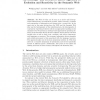Free Online Productivity Tools
i2Speak
i2Symbol
i2OCR
iTex2Img
iWeb2Print
iWeb2Shot
i2Type
iPdf2Split
iPdf2Merge
i2Bopomofo
i2Arabic
i2Style
i2Image
i2PDF
iLatex2Rtf
Sci2ools
OTM
2005
Springer
2005
Springer
An Ontology- and Resources-Based Approach to Evolution and Reactivity in the Semantic Web
Abstract. The Web of today can be seen as an active and heterogeneous infrastructure of autonomous systems, where reactivity, evolution and propagation of information and changes play a central role. In the same way as the main driving force for XML and the Semantic Web idea was the heterogeneity of the underlying data, the heterogeneity of concepts for expressing behavior calls for an appropriate handling on the semantic level. We present an ontology-based approach for specifying behavior in the Semantic Web by Event-Condition-Action (ECA) rules that models rules as well as their event, condition, and action components, and languages as resources. The necessary information about semantics and suitable processors is then associated with the language resources. The approach makes use of the data integration facilities by URIs that allow for a seamless integration of information and services physically located at different places. Additionally, that point of view allows for sharing and ...
| Added | 28 Jun 2010 |
| Updated | 28 Jun 2010 |
| Type | Conference |
| Year | 2005 |
| Where | OTM |
| Authors | Wolfgang May, José Júlio Alferes, Ricardo Amador |
Comments (0)

